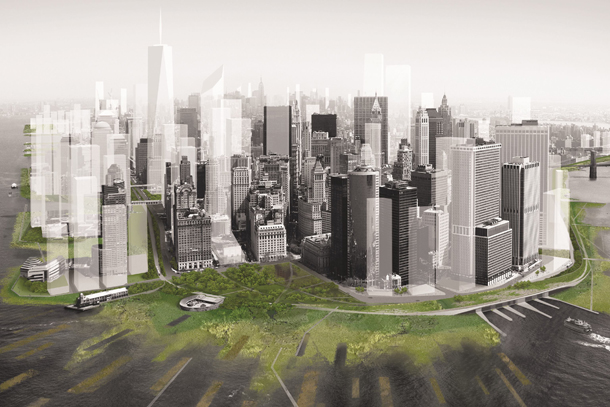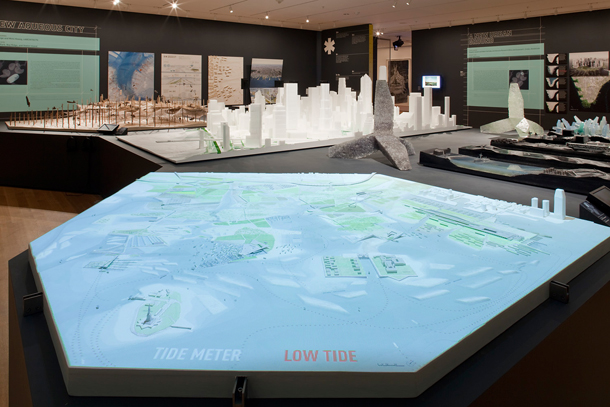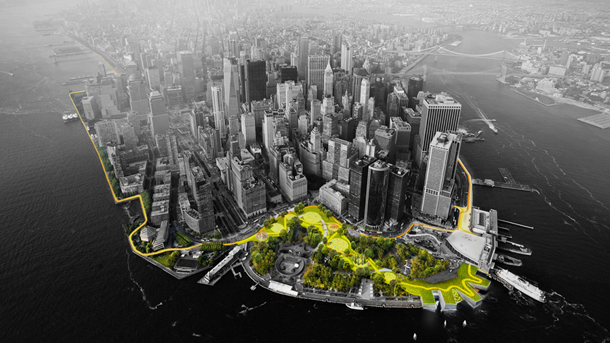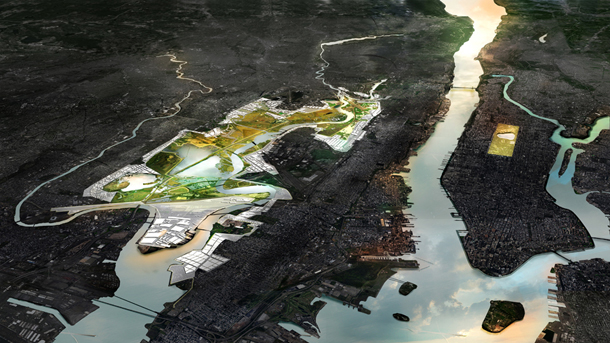Though I can’t recall when or where I heard it, I remember thinking that this was the appropriate vocabulary to talk about environmentalism – “resiliency”. The word encompassed so many new and exciting things. “Green” had been completely co-opted by marketers of virtually every product on the shelves of Home Depot and the neighborhood grocery store. “Sustainability” was nearing the state of complete semantic obliteration, being used variously to describe everything from economic plans, political regimes, as well as environmental agendas, and frankly it always aligned itself a little too closely to “conservative” attitudes. What could be more sustainable? Conserve resources. It became heavy on the pohibitionary side of things. Less was always more sustainable than more, and one got the idea that inaction, possibly even in the extreme (death) would be the most sustainable state of all. But not resiliency. Resiliency embodied so many active and responsive attitudes. It’s aspirational and feels honestly closer to the natural systems that it emulates. Fields of tall sea grass blowing in the coastal winds don’t necessarily call to mind sustainability but they’re the poster-image of resilience.
Resilience is a characteristic of a system, organism, government, structure or object to withstand shock. The term speaks about the capacity to recover from extreme trauma and to rebuild, recover and resurrect. Other words associated with resiliency are elasticity and redundancy. There is also a hint of eastern mysticism in the phrase, in contrast to a more western attitude of resistance (i.e. bend and yield vs. fortify).

Image above: Rising Currents proposal image. Credit Architecture Research Office and dlandstudio.
But it seems I may have been harboring a naive point of view ripe for disabusal. There’s no doubt that it has now become the term du jour, leaving those sorry folks still haranguing on about sustainability appearing to be sorely out of touch with the current trends in environmentalism. There’s also no doubt that in the roughly 10 years that resiliency has be in the common lingo, it has started to take on some of the less nuanced characteristics that lead the fall of “sustainable.” Surely some of this lexical evolution is expected. But recently I’ve been surprised to read critiques of resiliency, and it has little to do with environmentalism.


Images above: Rising Currents. ©2010 Museum of Modern Art, NY. Imaging Services. Photograph by Thomas Griesel.
Recent articles published by Ross Exo Adams, Bruce Braun, and Marc Neocleous, in response to two major works on resilient design, the Rising Current’s show at MoMA in 2010 and the more recent Rebuild By Design show illustrate that “Resilience”, is not necessarily the all-positive, progressive and knowledgeable term that I had once embraced. For example, as Mr. Neocleous cites, in the decade after 9/11 “resilience” was increasingly used as a word to describe essential components of military and civilian preparedness. But perhaps even more interesting is the term’s ability to reflect a particular zeitgeist about our state in the world vis-a-vis fear and catastrophe – economic, political, environmental or otherwise.
Writing in response to the Rebuild By Design competition, Bruce Braun and Stephanie Wakefield remind us that rather than merely appreciating these works of resilience for what they show, “it is also possible to read these exhibits, programs and articles, as they are often read by critics on the left, as the cultural logic of whatever new stage of capitalism we have entered, providing ideological cover for the restructuring of urban space and the new forms of dispossession and exploitation that it requires. “ (Braun and Wakefield, 3/8)
Image above: Rebuild by Design entry from BIG (Bjarke Ingels Group) with One Architecture, Starr Whitehouse, James Lima Planning + Development, Project Projects, Green Shield Ecology, AEA Consulting, Level Agency for Infrastructure, Arcadis, and the Parsons School of Constructed Environments
Despite their beautiful renderings of future wetland and eco-preserves “each exhibit weaves a story about the past, present and future that has significant consequences for how we think about the present and its political possibilities.” And further “each exhibit raises key questions about how we understand and respond to the present conjuncture we now almost casually call the anthropocene.” (Braun and Wakefield, 4/8)
Here Braun and Wakefield ask us to consider the larger implications of Resilience as a framework for the production of work and policy within our current times. And as we are so often quick to forget, it’s never a win-win. So what’s at risk? Ross Exo Adams, drawing on Braun’s readings extends the critique to include the very thing that Resiliency is intended to protect:
“Resilience in other words, incorporates the ‘natural processes’ of nature into a technologically totalizing economy that renders urban space and human life inseparable from subtle techniques and technologies of government, which now include calculations of the complexities of the climate itself.” (Adams 132)
For Adams, the active engagement of natural systems in many of the design proposals featured in the RBD and Rising Currents, demonstrates a kind of final cooption of the natural world for economic and political gain.
Is this a new or bad thing? One might surmise that this is an extension of human agency within the environment and one could probably counter that, since Humanity is already unintentionally transforming the physical world (through the introduction of carbon emissions, heavy metal waste, nuclear waste, garbage, deforestation, you get the point) that any conscious effort to co-opt natural processes for “good” or positive change is a step in the right direction. The fact is that we’re global change agents we might as well own-up to it. But I’m not sure that this is what Adams was suggesting. Alternatively Bruce Braun correctly points out the underlying classism to much of the resilience movement where scenarios – at least in RBD – focus closely to the economic survival of critical infrastructures – power grids, transportation networks, fresh water distribution – and not necessarily human habitation.
Image above: Rebuild by Design entry from MIT CAU + ZUS + URBANISTEN with Deltares; 75B; and Volker Infra Design.
But rather than critiquing individual products or intentions of a particular set of resilient projects I’m more interested in Resilience as a framework through which to view current geo-political events. Marc Neocleous, in his article “Resisting Resilience” draws our attention to underlying structures and past usages of this phrase.
“The first thing to do note is the impact this is having on the concept of security. The National Security Strategy for the United States of America (2002) published as a major statement of US strategy following 9/11, mentions ‘resilience’ just once. In contrast, five years later the National Strategy for Homeland Security (2007) is almost obsessed with the idea of resilience. The document outlines the need for ‘structural and operational resilience of… critical infrastructure and key resources’, but resilience is also planned for the system as a whole and even for the “American spirit” with the overall aim to ‘disrupt the enemy’s plans and diminish the impact of future disasters through measures that enhance the resilience of our economy and critical infrastructure.” (Neocleous, 3)
I am interested in how resiliency relates to the current ability (inability) of government, not just US, but government in general, to provide the most basic forms of protection to its constituents in the face of economic, ecological, or political extremist disaster. My assertion here is that resilience, as an organizing construct for infrastructural, economic and social policy disperses previously held governmental responsibilities onto the public and private spheres. As Neocleous suggests the word is frankly, brilliant at simultaneously connoting vulnerability and strength.
“As well as being newer, better, and bolder, resilience is also more imaginative. For resilience both engages and encourages a culture of preparedness… In this way the logic of security in the form of preparedness for a terrorist attack folds into a much broader logic of security in the form of preparation for an unknown disaster. Resilience is nothing if not an apprehension of the future, but a future imagined as disaster and then, more importantly, recovery from disaster” (Neocleous, 4).
This shift in language, away from that of protection, defence, and sustainability and towards with a language of resilience, resurgence, etc… reflects not only changes in the eco-political world with respect to natural disasters, but market forces, terrorist attacks, political extremism and our modern methods of government inability to shield us from these harms.
In a very subtle and effective way it is a capitulation of national governments, suggesting that in the face of these global disasters that governments, law, (even perhaps reason?) may in fact be powerless against them. Resilience embodies a state of perpetual individual preparedness, where each citizen is a resilient component in a larger system. Which again is both empowering and terrifying (i’m in charge of my own destiny vs. nothing other than my own preparedness will protect me).
“…Resilience comes to form the basis of subjectively dealing with the uncertainty and instability of contemporary capitalism as well as the insecurity of the national security stage” (Neocleous, 5).
What is one to do, living as we do in this state of perpetual disaster and catastrophe? Well, one can always “follow the money.” A particularly bleak and marxist reading of the situation would be to extend Neocleous’s reading one step further into the realm of conspiracy, where global powers, the media, big-oil etc… are perpetuating a seemingly unending state of crisis to keep an unknowing population in disarray all the while reaping the benefits of a society in a continuous state of anticipation of disaster (psudo-war? War on Terror, War on Drugs, War on Poverty…). But maybe this scenario seems to miss the point, or a larger point.
The argument being laid out here, Braun’s reading of the state’s cooption of “nature” and Neocleous’ militarized critique hinge on a basic assumption that these conditions are either unique to our time or condition. In short, it is to say that Resilience is a pressing condition to humans living in this era in the age of technologised capitalism in the Anthropocene. Where as, to add a slightly different twist to this line of thinking, my mind turns to Hyper-Objects, by Tim Morton and Perspectives of the Environment by Tim Ingold.
My ruminations in the next posting will enfold a non-human perspective to this current reading of Resilience. To what degree is resilience framed by a humanistic mono-species view? And struggle with question such as are we, in fact in a more dangerous world? Is this also critique of the ability of reason, language and knowledge to solve complex problems in our increasingly dynamic world? Was this ever possible to begin with? More to follow…
_____________________________________________________________________________________________________
Notes from a Resilient City
Ross Exo Adam, in Log 32, Anyone Corporation, pp 127 – 139
“Resilience as a discursive object seems to pick-up where others like sustainability or ecological urbanism leave off, promising scientifically tuned proposal for climate remediation that also happen to fuel commercial development. What gives resilience its force and inexorability is its ability to incorporate a concrete crisis in its own discursive political formation. Unlike sustainability, or ecological urbanism, it immediately frames itself as a program of response to crisis rather than a speculative means to attenuate the impact of an unknown future crisis. As such, the project of resilience can construct itself in purely pragmatic terms of real damage information together with standard risk probability data, thus shedding all theoretical conjecture. In the discourse of resilience, theory and event collide in an indistinguishable set of demands whose consistency, as RBD (Rebuild by Design) demonstrates, is rendered clearest in terms of risk, remediation, and retail – that is, it promises both disaster relief and commercial urbanization simultaneously.” 127
“While architects and designers generally seem to welcome this program, resilience as a discourse has not come uncriticised. Indeed, in the social sciences it is subject of fierce debate. Political historian mark Neocleous suggests that resilience is simply our “newest fetish,” which inherently precludes modes of political activism though its neutralizing methods of consensus building around what is ultimately only the resilience of the state and of capital.” 128
“Commenting on a similar set of projects commissioned for “Rising Currents” an exhibition at the Museum of Modern Art in 201. Bruce Braun argues that it is precisely the incorporation of so-called “nature” into large-scale systems of infrastructure as a means of modulating and eventually cancelling it that constitutes a properly biopolitical regime of urban management. Drawing on Michel Foucault’s work he shows that resilience hedges its bets on the “naturalness of nature” which emerges as both the object and technique of government.” 131
“Resilience in other words, incorporates the “natural processes” of nature into a technologically totalizing economy that renders urban space and human life inseparable from subtle techniques and technologies of government, which now include calculations of the complexities of the climate itself.” 132.
“the implications of this extend even further: as Braun reminds us, “security is thus increasingly about protecting “critical infrastructures” and biopolitics is increasingly infrastructural in form. beyond the rhetoric of healthy lifestyle, at state in these projects is a massive reorganization of power in space and the broad incorporation of urban life in a new cybernetics machine of governance.” 132.
Inhabiting the post apocalyptic city:
Bruce Braun and Stephanie Wakefield, Environment and Planning D, Society and Space.
http://societyandspace.com/material/article-extras/theme-section-a-new-apparatus-technology-government-and-the-resilient-city/bruce-braun-and-stephanie-wakefield-inhabiting-the-postapocalytic-city/
“It is also possible to read these exhibits, programs and articles, as they are often read by critics on the left, as the cultural logic of whatever new stage of capitalism we have entered, providing ideological cover for the restructuring of urban space and the new forms of dispossession and exploitation that it requires…” 3/8
“in their presentation of future risks, and splashy presentations of exciting new adaptive designs and technologies, each exhibit weaves a story about the past, present and future that has significant consequences for how we think about the present and its political possibilities. or, perhaps more constructively, each exhibit raises key questions about how we understand and respond to the present conjuncture we now almost casually call the anthropocene.” 4/8
Resisting Resilience
Mark Neocleous in Radical Philosophy 178 March/April 2013
http://www.radicalphilosophy.com/commentary/resisting-resilience
“Resiliency has in the last decade become one of the key political categories of our times… stemming from the idea of system and originating in ecological thought, the term connotes the capacity of a system to return to a previous state, to recover from a shock, or to bounce back after a crisis or trauma.” 1
“The first thing to do note is the impact this is having on the concept of security. The National Security Strategy for the United States of America (2002) published as a major statement of US strategy following 9/11, mentions ‘resilience’ just once. In contrast, five years later the National Strategy for Homeland Security (2007) is almost obsessed with the idea of resilience. The document outlines the need for “structural and operational resilience of… critical infrastructure and key resources”, but resilience is also planned for the system as a whole and even for the “American spirit” with the overall aim to ‘disrupt the enemy’s plans and diminish the impact of future disasters through measures that enhance the resilience of our economy and critical infrastructure.” 3
“As well as being newer, better, and bolder, resilience is also more imaginative. For resilience both engages and encourages a culture of preparedness… In this way the logic of security in the form of preparedness for a terrorist attack folds into a much broader logic of security in the form of preparation for an unknown disaster. Resilience is nothing if not an apprehension of the future, but a future imagined as disaster and then, more importantly, recovery from disaster.” 4
“…Resilience comes to form the basis of subjectively dealing with the uncertainty and instability of contemporary capitalism as well as the insecurity of the national security stage.” 5









